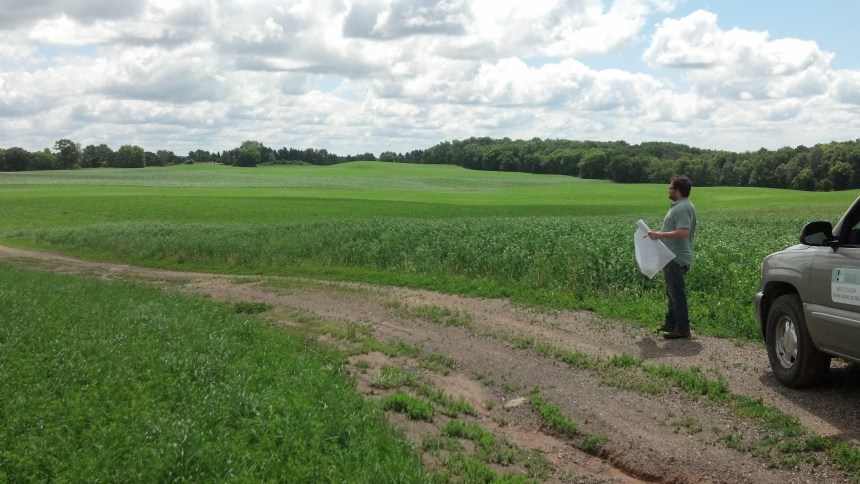A story of redemption
26 years ago, Brian Axdahl and his father bought an old sod farm near the St. Croix River and plowed the turf under with moldboard plows. The soil was compacted from years of poor management. Lakes formed in the fields whenever it rained, and runoff flowed to the river, carrying sediments and nutrients with it.
Over the years, the Axdahls slowly nursed their farmland back to good health. Brian worked with the Washington Conservation District to build an earthen dam nearly a mile long with a controlled outlet structure to hold back runoff. He put eight acres of land into a conservation easement with the Minnesota Land Trust and planted native prairie to provide habitat for birds and pollinators. He began to plant cover crops in the winter, and started practicing no-till as well. Over time, the earth responded. Now, there is hardly any runoff, the soil is healthier, crops do better during drought, and there are no lakes when it rains.

The Axdahls now farm 550 acres of land spread out over several separate parcels within a 10-mile area. Brian grows fresh sustainably-grown produce for market and for members of their Community Supported Agriculture (CSA) program, and grows green beans and sweet corn for whole-sale. He recently became one of 27 farmers in Washington County to be certified through the Minnesota Agricultural Water Quality Certification program.
How’s the water Minnesota?
Minnesota may be the “Land of 10,000 Lakes” but it turns out that only about 6000 are clean enough for fishing and swimming. Statewide, roughly 40% of our rivers, lakes and streams are officially listed as impaired by problems including too much mercury, too much bacteria, too many nutrients, or too few fish.

Runoff from farm fields and increased flow from ditches and drain tile is estimated to deliver 57-78% of the excess phosphorus to the Mississippi and St. Croix Rivers, as well as large loads of sediment. In some parts of the state, nitrates have leached into groundwater, making well water unsafe to drink. As study after study points a finger at modern agriculture, many farmers in our state are beginning to feel defensive.
Yet, these statistics only tell part of the story. Per acre, urban landscapes actually contribute as much or more pollution to our waterways as farmland. Without practices such as stormwater ponds and raingardens in place, runoff from parking lots and roads can send a cocktail of pollutants into nearby lakes and streams. Because farmland covers more total area than cities and towns, however, it has a proportionately larger impact on our major river systems. In the Lower St. Croix watershed, for example, approximately half of the land is devoted to cropland and pastures, while only 9% is developed.

Like Brian Axdahl, many farmers in Minnesota are already working hard to protect the environment. They’re making changes to their tillage and fertilization practices, trying out new crops, and looking for ways to reduce erosion. The MN Ag Water Quality Certification was developed as one way to provide recognition to farmers as they make these changes.
Charting a path to a greener (and bluer) future
In the Lower St. Croix watershed, local government partners are working to develop a shared watershed plan that will guide conservation work in our region over the next ten years. The goal is to support healthy ecosystems, recreation, public health, tourism, and quality of life, while still retaining local agriculture and a vibrant economy. As part of this effort, partners spoke with more than 400 farmers in Washington, Chisago, Anoka, Isanti and Pine Counties.

The Lower St. Croix “One Watershed” plan is currently under final review by the MN Board of Water and Soil Resources and will likely be implemented beginning in 2021: www.lsc1w1p.org

